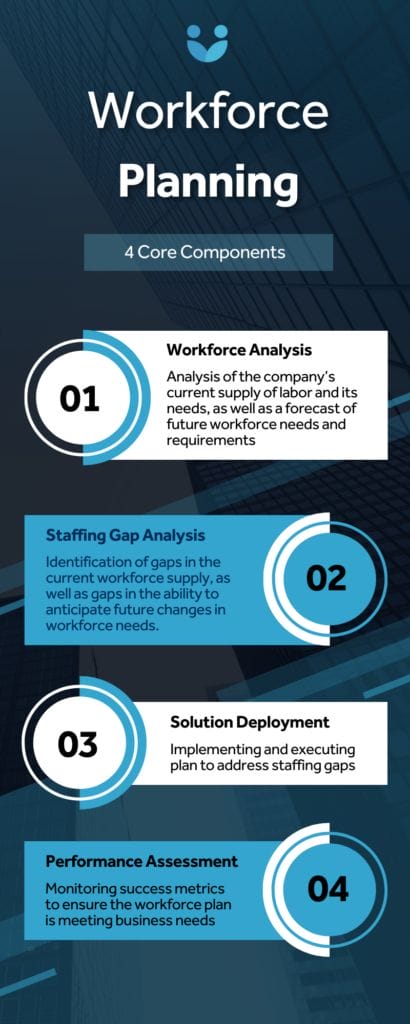Summary
-
Requesting and collecting data in real-time allows your management to make better business decisions and keep costs low.
-
Focus on gathering insights that will ultimately address your business needs.
-
With labor analytics, variety is key. Use and collect data from multiple sources.
Data plays a vital function in all aspects of running a business. It is used in everything, from analyzing and predicting product performance to segmenting and understanding your customers in order to optimize the user experience.
So naturally, data has an important role to play in workforce management through the process of labor analytics – also known as workforce analytics. Through labor analytics, HR professionals gather and analyze workforce data to:
- Understand what new roles and functions a company should seek to fill and which ones it should cut.
- Understand what roles and functions might require a reduction or elimination altogether.
- Forecasting the value and success a prospective employee can bring to a company.
- Obtain actionable insights on how to better manage labor costs.
- Gain a deeper understanding of the employee experience and what positively boosts employee engagement.
- Optimize business strategy in a way that increases performance and productivity.
- Make data-driven business decisions on fair and cost-effective worker compensation and incentives.
The good news is that most businesses already have access to massive amounts of workforce data – the catch is that gathering and making sense of this data can be tricky. But in the end, the benefit of utilizing labor analytics significantly outweighs the effort spent organizing the data.
Research shows the positive impact that workforce analytics has on business outcomes. Case studies show that companies that use labor analytics say they have a clearer understanding of their workforce needs and can identify employees with high potential. They have also noted an improvement in retention rates and are generally happier with their human resources.
Webinar: How to Stop Employee Turnover
Since the pandemic, attracting talent has never been trickier, and the benefits of labor analytics cannot be overstated. Following these four steps will help you optimize your labor analytics process and put your business in a better position for success.
Gather analytics data in real-time
It is essential that your C-suite decision-makers have access to labor analytics in real-time, before they need to make critical business decisions. Visibility like this improves response time to frontline labor issues and ensures a more efficient allocation of resources.
Real-time analytics give managers a clear picture of labor costs as a percentage of revenue across all locatins and throughout the day, allowing them to see where and when their workforce is struggling. This way, they can make better decisions regarding staffing levels, absenteeism, overtime, and more.
Whitepaper: Workforce Analytics
Connect labor analytics with business needs
While organizations should always make decisions on the most current data available, having too much data can hinder decision-making. Labor analysis shouldn’t be aimless in scope. Each research activity should address a specific question that needs answering by the organization. In other words, business outcomes need to guide the analytics process in the right direction.
Use multiple types of data and analytics
To best utilize data analytics, using multiple, targeted sources of data — including business-appropriate performance analytics and HR/talent management analytics — is important. But it’s not enough. In workforce analytics, variety is key.
Internal reports focus on metrics such as completed training hours or satisfaction with training. Predictive modeling uses statistical analysis to project the outcome of various actions. And external benchmarking allows an organization to compare itself against the industry-standard. Incorporating data from a variety of analytics types gives the business a more robust viewpoint, allowing for better-informed decision-making.
Avoid common data analytics mistakes
Organizations should be sure to avoid common pitfalls when using analytics. The data needs to be organized and cleaned, and organizations should start with small, simple projects rather than something big to help get leadership buy-in.
They should also be careful not to confuse correlation with causation in research results. For example, if data shows that older employees are more successful at a task than younger employees, that may have nothing to do with age demographics but with years of experience.
Data literacy – “the ability to read, write, and communicate data in context” — is a vital skill for any business today, according to 2019 Gartner research. Some companies may still have ways to go to maximize the potential of their labor analytics. Hiring a chief data officer or data scientist or outsourcing analytics capabilities to a vendor can help make sense of the data that’s collected.
The growing importance of data analytics is inevitable. For the unprepared company, this may be intimidating. Getting leadership buy-in and using data analytics strategically to achieve a specific business outcome can help. But once the organization gets a handle on its labor analytics function, it can expect promising business outcomes.
Optimize your labor analytics process with Workforce.com
Utilizing labor analytics tools like Workforce.com makes it easier to turn your data into real-time, actionable insights. These insights help you more efficiently tackle frontline labor issues like:
- Predicting future hiring requirements
- Understanding current staffing needs
- Managing compensation and overtime
- Understanding and optimizing employee engagement
If you’re interested in using workforce management software to improve both your labor analytics and your bottom line, check out our webinar below featuring exclusive research from a Forrester TEI report:
Building a Business Case for WFM Software
For more information, get in touch with us now.









